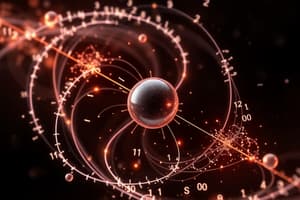Podcast
Questions and Answers
What is the fundamental property of electrons that determines their intrinsic angular momentum, and how is it measured?
What is the fundamental property of electrons that determines their intrinsic angular momentum, and how is it measured?
Electron spin; it is measured in units of the reduced Planck constant (ħ) and is denoted by the symbol s.
What are the two possible spin states of an electron, and what are they referred to as?
What are the two possible spin states of an electron, and what are they referred to as?
+1/2 and -1/2; they are referred to as 'up' and 'down' spin states, respectively.
What is the type of chemical bond that forms between two atoms that have a large difference in electronegativity, and what is the result of this bond?
What is the type of chemical bond that forms between two atoms that have a large difference in electronegativity, and what is the result of this bond?
Ionic bond; the result is the transfer of one or more electrons from one atom to another, resulting in the formation of ions with opposite charges.
What is the term for the positively charged ion that forms when an atom loses an electron, and what is the term for the negatively charged ion that forms when an atom gains an electron?
What is the term for the positively charged ion that forms when an atom loses an electron, and what is the term for the negatively charged ion that forms when an atom gains an electron?
What is the electrostatic attraction between oppositely charged ions that holds them together and forms an ionic bond, and what type of bonds are typically found in many minerals and salts?
What is the electrostatic attraction between oppositely charged ions that holds them together and forms an ionic bond, and what type of bonds are typically found in many minerals and salts?
What is the name of the compound that forms when calcium (Ca) and carbon (C) combine to form an ionic bond, and what is the name of the compound that forms when sodium (Na) and chlorine (Cl) combine to form an ionic bond?
What is the name of the compound that forms when calcium (Ca) and carbon (C) combine to form an ionic bond, and what is the name of the compound that forms when sodium (Na) and chlorine (Cl) combine to form an ionic bond?
What determines the element of an atom, and what is unique about the number of protons in each element?
What determines the element of an atom, and what is unique about the number of protons in each element?
What is the charge and mass of neutrons?
What is the charge and mass of neutrons?
What is the relationship between the number of electrons and protons in an atom?
What is the relationship between the number of electrons and protons in an atom?
What is the purpose of energy levels or shells in an atom?
What is the purpose of energy levels or shells in an atom?
What is atomic mass, and how is it measured?
What is atomic mass, and how is it measured?
What is the significance of the number of neutrons in an atom?
What is the significance of the number of neutrons in an atom?
Flashcards are hidden until you start studying
Study Notes
Electron Spin
- Electron spin is a fundamental property of electrons that determines their intrinsic angular momentum.
- Electron spin is quantized, meaning it can only take on specific discrete values.
- The spin of an electron is measured in units of the reduced Planck constant (ħ) and is denoted by the symbol s.
- The spin of an electron can be either +1/2 or -1/2, which are referred to as "up" and "down" spin states, respectively.
- Electron spin is responsible for the magnetic moment of an electron, which is a measure of its tendency to produce a magnetic field.
- The spin of an electron is important in understanding the behavior of atoms in magnetic fields and the formation of chemical bonds.
Ionic Bonds
- Ionic bonds are a type of chemical bond that forms between two atoms that have a large difference in electronegativity.
- Ionic bonds involve the transfer of one or more electrons from one atom to another, resulting in the formation of ions with opposite charges.
- The atom that loses an electron becomes a positively charged ion, known as a cation.
- The atom that gains an electron becomes a negatively charged ion, known as an anion.
- The electrostatic attraction between the oppositely charged ions holds them together and forms an ionic bond.
- Ionic bonds are typically strong and are found in many minerals and salts.
- Examples of ionic bonds include the bonds between sodium (Na) and chlorine (Cl) in table salt (NaCl) and between calcium (Ca) and carbon (C) in limestone (CaCO3).
Electron Spin
- Electron spin is a fundamental property that determines an electron's intrinsic angular momentum.
- Electron spin is quantized, taking on specific discrete values measured in units of the reduced Planck constant (ħ).
- The spin of an electron can be either +1/2 (up) or -1/2 (down) spin states.
- Electron spin is responsible for an electron's magnetic moment, a measure of its tendency to produce a magnetic field.
- Electron spin is crucial in understanding atomic behavior in magnetic fields and chemical bond formation.
Ionic Bonds
- Ionic bonds form between atoms with a large difference in electronegativity.
- Ionic bonds involve the transfer of one or more electrons, resulting in oppositely charged ions.
- The atom that loses an electron becomes a positively charged ion (cation).
- The atom that gains an electron becomes a negatively charged ion (anion).
- Electrostatic attraction between oppositely charged ions holds them together, forming an ionic bond.
- Ionic bonds are typically strong and are found in many minerals and salts.
- Examples of ionic bonds include NaCl (table salt) and CaCO3 (limestone).
Atomic Structure
- An atom is the smallest unit of a chemical element that retains the properties of that element.
- Consists of three main parts: protons, neutrons, and electrons.
Protons
- Positively charged particles found in the nucleus (center) of the atom.
- Determine the element of an atom, with each element having a unique number of protons.
- Have a positive charge and a mass of approximately 1 atomic mass unit (amu).
Neutrons
- Particles found in the nucleus with no charge.
- Can vary in number, leading to different isotopes (atoms of the same element with different numbers of neutrons) of the same element.
- Have a mass of approximately 1 amu.
Electrons
- Negatively charged particles that orbit the nucleus of the atom.
- Equal in number to protons, and this number determines the chemical properties of an element.
- Have a negative charge and a very small mass compared to protons and neutrons.
Energy Levels (Shells)
- Electrons occupy specific energy levels or shells around the nucleus.
- The closest shell to the nucleus can hold up to 2 electrons, the next shell can hold up to 8 electrons, and so on.
- Electrons in outer shells are involved in chemical bonding.
Atomic Mass
- The total mass of an atom, including protons, neutrons, and electrons.
- Measured in atomic mass units (amu).
- Used to distinguish between different isotopes of the same element.
Studying That Suits You
Use AI to generate personalized quizzes and flashcards to suit your learning preferences.



